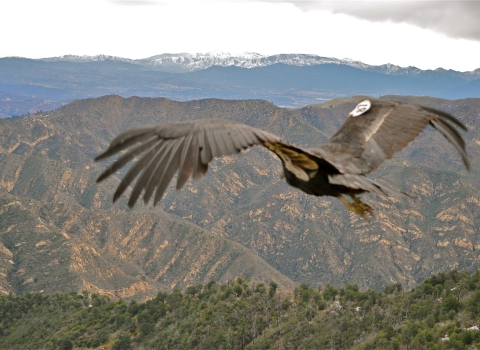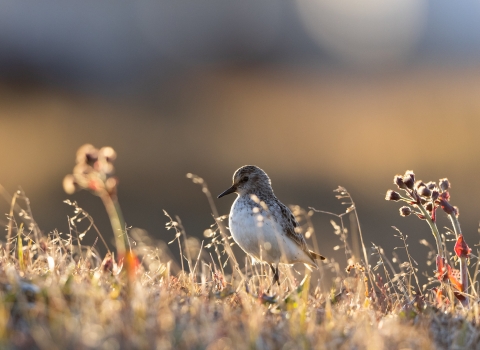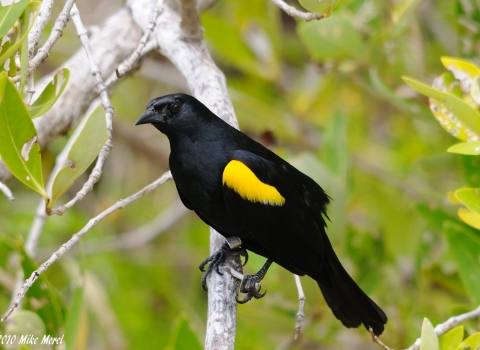For the first time in years, choking mats of an invasive plant pest are receding from Midway Atoll National Wildlife Refuge, opening critically needed nesting space for rare seabirds like the albatross. As cornstalk-high stands of Verbesina encelioides, or golden crownbeard, yield to an assault by the U.S. Fish and Wildlife Service, hope for the birds is rising.
More seabirds nest and more chicks survive in Midway’s native grass than in non-native Verbesina, finds the Service, which is conducting the Verbesina eradication with a $1 million National Wildlife Refuge System grant and matching funds from the National Fish and Wildlife Foundation.
Laysan and black-footed albatrosses nested at near-record levels in 2012-2013 at Midway Atoll in the Pacific, though biologists will need three or more years to know if the rise is due to Verbesina control. Another potentially promising sign: the January hatching of a short-tailed albatross chick, one of the world’s most endangered seabirds. The hatching was only the third in recorded history outside of three small islands near Japan; the earlier hatchings also occurred on Midway after plant control efforts began.
In addition to the three albatross species, the endangered Laysan duck and 18 other seabird species are expected to benefit from Verbesina’s removal.
“The early success of this project is exciting, because the techniques we’ve developed could help control invasive plants in other island environments and perhaps even on the U.S. mainland,” says John Klavitter, invasive species invasive species
An invasive species is any plant or animal that has spread or been introduced into a new area where they are, or could, cause harm to the environment, economy, or human, animal, or plant health. Their unwelcome presence can destroy ecosystems and cost millions of dollars.
Learn more about invasive species coordinator for the Refuge System and Midway Refuge’s former deputy manager. “Invasive species — non-natives that harm the environment, economy or people — are extremely challenging to manage, let alone remove,” added Klavitter.
Midway Atoll Refuge, part of the Papah?naumoku?kea Marine National Monument, is the site of a pivotal World War II battle in which the U.S. Navy defeated the Japanese fleet in June 1942. The former Navy air station became a national wildlife refuge national wildlife refuge
A national wildlife refuge is typically a contiguous area of land and water managed by the U.S. Fish and Wildlife Service for the conservation and, where appropriate, restoration of fish, wildlife and plant resources and their habitats for the benefit of present and future generations of Americans.
Learn more about national wildlife refuge in 1988, managed by the Service. Midway hosts one of the world’s largest albatross colonies.
Verbesina was introduced to Midway, probably in the 1930s, from the southwestern United States and Mexico. By the late 1990s, when eradication efforts began, the plant covered most of Midway’s three islands, reducing seabird nesting density, reproductive success, albatross chick survival and biodiversity. Verbesina is an annual plant in the daisy family. It grows rapidly each year, forming thick stands that reduce albatross nesting and limit air flow to chicks in their nests, putting them at risk of death from dehydration.
For the past two years, crews have hand-sprayed Verbesina almost daily with herbicides; year-round seabird nesting precludes the use of tractors or heavy equipment. Midway’s remote location, 1,200 miles from Honolulu, also adds challenges.
“We need to ship all herbicides and equipment from Honolulu, and we only have two to three supply ships a year,” says Service bio-technician and project crew leader Greg Schubert. Eradication efforts have focused on Midway’s uninhabited Eastern Island, reachable only by boat from Sand Island.
Despite the logistical challenges, the spraying has knocked out most mature Verbesina plants on 335-acre Eastern Island. If all goes well, emergent seedlings will be gone by early 2017 on Eastern and Spit islands and by early 2018 on bigger Sand Island. Native grasses and other native plants are being replanted to restore seabird nesting habitat, secure coral sand and build coastal dunes to protect against waves.
To guard against re-infestation or invasion of another atoll, the Refuge imposes strict quarantine procedures. All personnel traveling to Eastern Island must pass through shoe-cleaning stations at the boat pier. All equipment is cleaned before transport from Honolulu to Midway and before use on Eastern Island. Travelers from Honolulu to Midway must also clean their shoes and gear before flights and voyages. Only new clothing and thoroughly cleaned equipment are allowed at the other atolls and islands within the Papah?naumoku?kea Marine National Monument.
Midway Atoll provides habitat for some 3 million seabirds of 21 species, including 1.5 million Laysan albatrosses; this accounts for about 65 percent of the global population, making it the world’s largest Laysan albatross colony. Nineteen of 21 species of albatrosses are threatened with extinction, according to the International Union for the Conservation of Nature.
“We are committed to working with the Service to enhance the quality of habitat at Midway for nesting seabirds and native biodiversity,” says Scott Hall, Seabird Conservation Manager for the National Fish and Wildlife Foundation. “This partnership and the generosity of private donors are helping to make this commitment a reality.”
###
A nonprofit chartered by Congress in 1984, the National Fish and Wildlife Foundation sustains, restores and enhances the nation’s fish, wildlife, plants and habitats. NFWF creates partnerships between the public and private sectors to invest in conservation and the sustainable use of natural resources. To date, NFWF has awarded more than 12,000 grants to more than 4,000 organizations in the U.S. and abroad and leveraged – with its partners – more than $618 million in federal funds into over $2.1 billion for conservation. For more information, visit www.nfwf.org.
The National Wildlife Refuge System protects wildlife and wildlife habitat on more than 150 million acres of land and water from the Caribbean to the Pacific, Maine to Alaska. Refuges also improve human health, provide outdoor recreation and support local economies. Visit our home page at www.fws.gov/refuges. Follow us on Facebook and Twitter.
The U.S. Fish and Wildlife Service works with others to conserve, protect, and enhance fish, wildlife, plants and their habitats for the continuing benefit of the American people. For more information, visit www.fws.gov, or connect with us through any of these social media channels: Facebook, Twitter, YouTube, Flickr.


